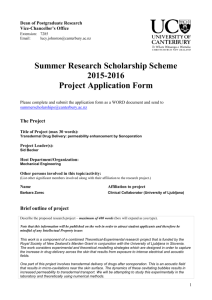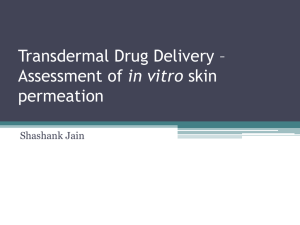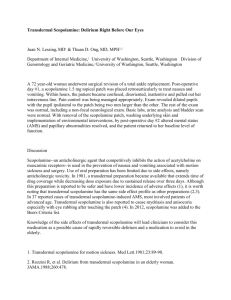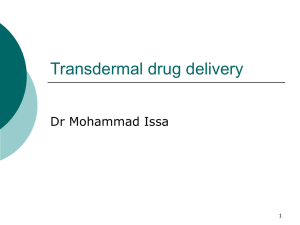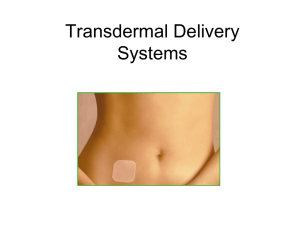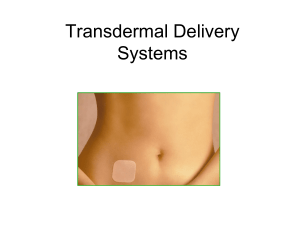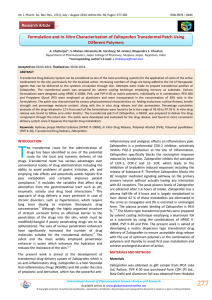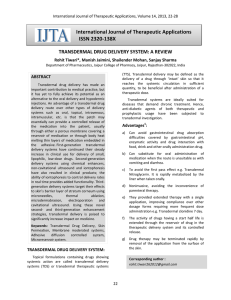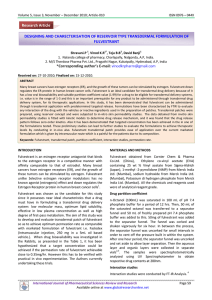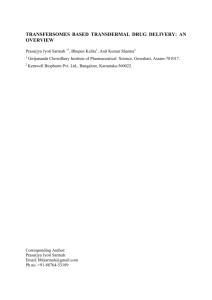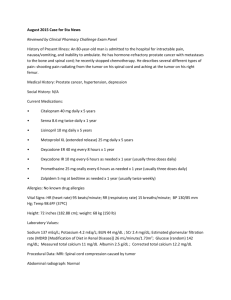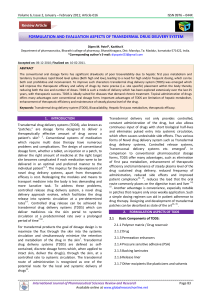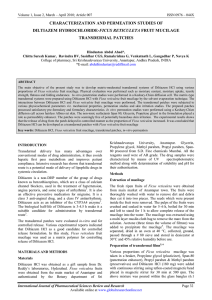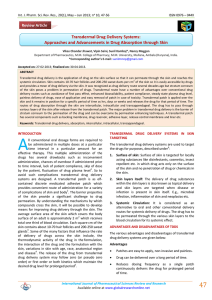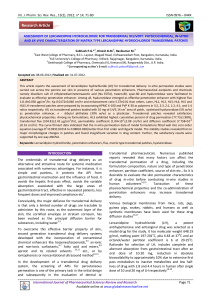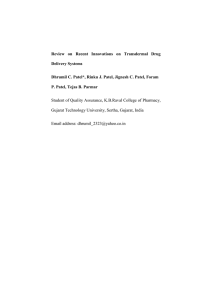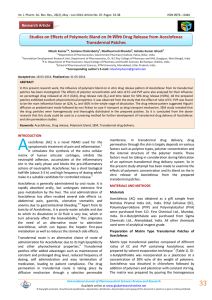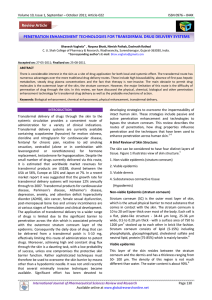Transdermal Drug Delivery
advertisement
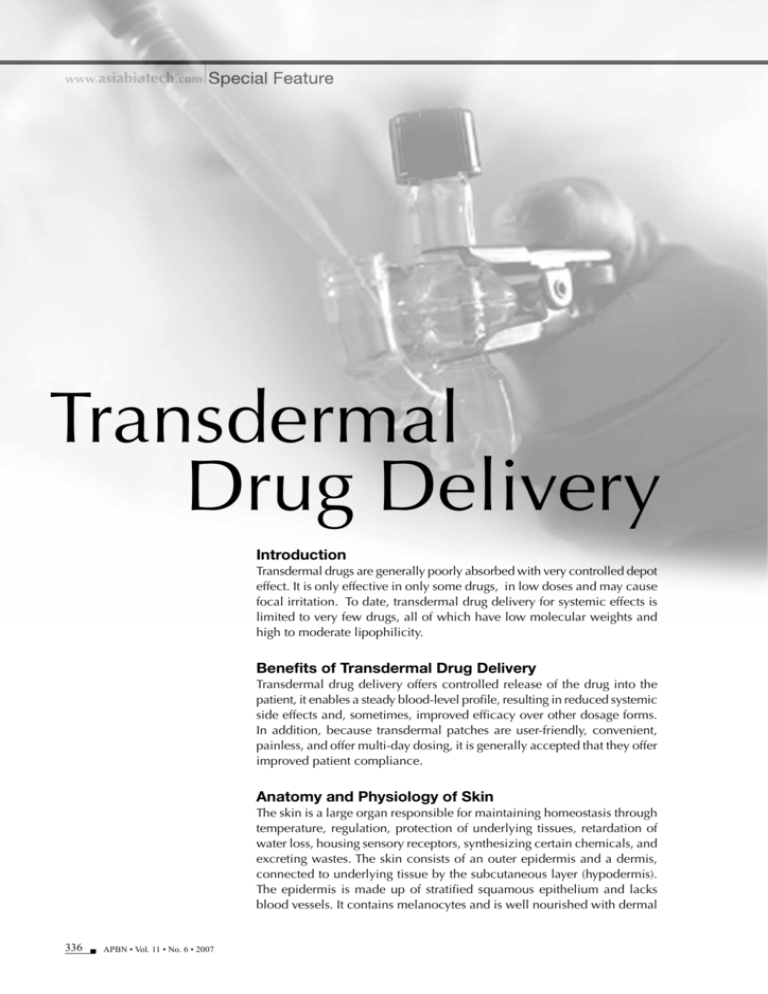
www.asiabiotech.com Special Feature Transdermal Drug Delivery Introduction Transdermal drugs are generally poorly absorbed with very controlled depot effect. It is only effective in only some drugs, in low doses and may cause focal irritation. To date, transdermal drug delivery for systemic effects is limited to very few drugs, all of which have low molecular weights and high to moderate lipophilicity. Benefits of Transdermal Drug Delivery Transdermal drug delivery offers controlled release of the drug into the patient, it enables a steady blood-level profile, resulting in reduced systemic side effects and, sometimes, improved efficacy over other dosage forms. In addition, because transdermal patches are user-friendly, convenient, painless, and offer multi-day dosing, it is generally accepted that they offer improved patient compliance. Anatomy and Physiology of Skin The skin is a large organ responsible for maintaining homeostasis through temperature, regulation, protection of underlying tissues, retardation of water loss, housing sensory receptors, synthesizing certain chemicals, and excreting wastes. The skin consists of an outer epidermis and a dermis, connected to underlying tissue by the subcutaneous layer (hypodermis). The epidermis is made up of stratified squamous epithelium and lacks blood vessels. It contains melanocytes and is well nourished with dermal 336 APBN • Vol. 11 • No. 6 • 2007 www.asiabiotech.com Special Feature blood vessels. The epidermis is important because it protects against water loss, mechanical injury, chemicals, and microorganisms. The dermis binds the epidermis to underlying tissues. The dermis consists of connective tissue with collagen and elastic fibers within a gel-like ground substance. Dermal blood vessels carry nutrients to upper layers of skin and help to regulate temperature. The dermis also contains nerve fibers, sensory fibers, hair follicles, sebaceous glands, and sweat glands. The subcutaneous layer (hypodermis) is composed of loose connective tissue and insulating adipose tissue. It binds the skin to underlying organs and contains the blood vessels that supply the skin. The accessory organs of the skin includes hair follicles, sebaceous glands, nails and sweat glands. First-Pass Effect The first-pass effect (or first-pass metabolism) is a phenomenon of drug metabolism. Transdermal delivery of a drug product allows for the avoidance of first pass metabolism by the liver and the delivery of a more even level of the therapeutic agent over the course of 24 hours. Dermal patches are the most common form of transdermal delivery of drugs. APBN • Vol. 11 • No. 6 • 2007 337 www.asiabiotech.com Special Feature Transdermal Gel Technology Transdermal gels are designed to deliver sustained drug amounts, resulting in systemically consistent levels. They represent an improvement compared with transdermal delivery by patches because they offer more dosage flexibility, less irritation potential and a better cosmetic appearance. Advanced transdermal delivery (ATD) gel technology was developed in order to provide enhanced passive skin permeation of various active drugs for the treatment of many conditions, including hypogonadism, female sexual dysfunction, postmenopausal symptoms, overactive bladder and anxiety. Transdermal Patches A transdermal patch or skin patch is a medicated adhesive patch that is placed on the skin to deliver a time released dose of medication through the skin and into the bloodstream. Transdermal patches are used to deliver a wide variety of pharmaceuticals. The most well-known skin patch nowadays is the nicotine patch which releases nicotine to help quitting the habit of tobacco smoking. Other skin patches administer estrogen for menopause and to prevent osteoporosis after menopause, nitroglycerin for angina, and lidocaine to relieve the pain of shingles (herpes zoster). Recent developments expanded their use to the delivery of hormonal contraceptives, antidepressants and even pain killers. Transcutaneous Immunization (TCI) Transcutaneous immunization (TCI) is a new method of vaccination that utilizes a topical application of an adjuvant and vaccine antigen to intact skin to induce an immune response. It combines the advantages of needle-free delivery while targeting the immunologically rich milieu of the skin. In this case, the goal is to deliver the antigen to the immune responsive Langerhans cells within the epidermis rather than to the systemic circulation. Typical antigens are very large proteins, or even whole cells, which have long been considered unsuitable for administration through an intact stratum corneum. Microneedles Microneedles are microscopic needles a few hundred microns in size, and they have been shown to increase transdermal flux of large molecular weight compounds by many fold. One of the ways in which this is achieved is to coat the compound onto microneedle shafts and insert them into the skin where they deposit their payload. They can pierce the skin in a minimally invasive manner without causing pain. Upon piercing skin they create micro-conduits across stratum corneum and provide a direct route for transport of drugs and vaccines into the skin. An example of this system is the 3M’s Microstructured Transdermal System (MTS). Other Technologies The skin’s topmost layer offers most resistance to transport of drugs across the skin. Different chemical and physical methods like chemical enhancers, ultrasound, electric energy, pressure driven flow, and lasers have been tried to disrupt the mass transfer resistance barrier of stratum corneum to deliver larger 338 APBN • Vol. 11 • No. 6 • 2007 www.asiabiotech.com Special Feature molecular weight and/or hydrophilic compounds. However, these methods have found limited clinical success. Iontophoresis is a method whereby a pair of adjacent electrodes placed on the skin set up an electrical potential between the skin and the capillaries below. At the positive electrode, positively charged drug molecules are driven away from the skin’s surface toward the capillaries. Conversely, negatively charged drug molecules would be forced through the skin at the negative electrode. Iontophoresis has the potential to expand the range of compounds available for transdermal delivery to include proteins and peptides and enhance skin transport. Because the current can be literally switched on and off and modified, iontophoretic delivery enables rapid onset and offset, and drug delivery is highly controllable and programmable. The other class of active transdermal delivery systems, known as poration technologies, uses high-frequency pulses of energy, in a variety of forms, temporarily to disrupt the stratum corneum, the layer of skin that stops many drug molecules crossing into the bloodstream. It is important to note that unlike iontophoresis, the energy used in poration technologies is not used to transport the drug across the skin, but facilitates its movement. These systems can achieve significant skin permeation enhancement, enabling the delivery of proteins, such as insulin and calcitonin. They also potentially offer significant improvements in control over the rate of drug delivery, but the resulting systems are more complex than passive transdermal systems. Transdermal Therapeutics Transdermal technologies may be applied for several categories of pharmaceuticals used for the treatment of disorders of the skin or for systemic effect to treat diseases of other organs. Several transdermal products and applications include hormone replacement therapy, management of pain. Diseases that can be Treated by Transdermal Drug Delivery Systems Skin Disorders Transdermal Insulin Delivery in Diabetes Fungus infections of Nails Erectile Dysfunction Hair Loss Menopause Cardiovascular Disorders Cancer Hypertension Anticancer Drugs and Vaccines Anticoagulants Pain Chronic Obstructive Pulmonary Disease NSAIDs Neurological and Psychiatric Disorders Smoking Cessation Parkinson’s Disease Transdermal Nicotine Replacement Depression Vaccination Alzheimer’s Disease HIV/AIDS Musculoskeletal Disorders Influenza Vaccine Osteoporosis Contraception Osteoarthritis Female/Male Contraception Hormonal Disorders APBN • Vol. 11 • No. 6 • 2007 339
